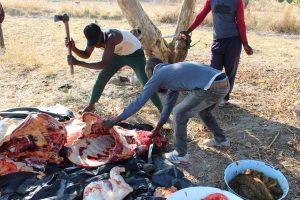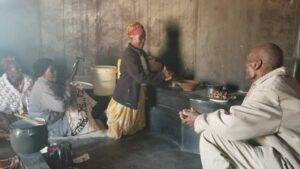‘mombe yeumai’ was paid many years ago
It has been decades since Ratidzai was married customarily and the bride price known as ‘roora’ or ‘pfuma’ was paid. A cow should have been paid as part of the brideprice to honour the bride’s mother ‘amai’ for her role as the nurturer and caregiver. However it is common that payment of the bride price could drag on for as long as one’s lifetime and then into generations. So this cow was paid a few years ago by Ratidzai’s son on behalf of his father who is long dead. Ratidzai has since been blessed with many grandchildren.
ritual is a sacrifice to appease the ancestors
Today, close family have gathered at the homestead of Ratidzai’s parents to witness the sacrificial ritual ‘madiro’. Here, amai’s cow will be slaughtered as a sacrifice to appease her ancestors and in return her good son in-law and his family granted protection and good fortunes. The tradition dictates that such sacrifice should be made only after the cow has had at least 2 calves. I failed to make it in time to witness the slaughter, which I am told involves some form of ritual too.

After the cow is slaughtered and some of the meat cooked (as the rest of the meat will be shared amongst members of the family at the end of the ceremony), the family gathers in the small round hut for the rest of the proceedings. Despite her being frail and old, amai attempts to perform the ritual herself but is talked out of it by her younger sister ‘mainini’ who offers to do it in her place under instruction. I realise that mainini will no doubt benefit by learning how it is done and hopefully pass it down to future generations. At that point, I can’t help but imagine that this could be the last generation that will ever perform this ritual as more young people shun customs that are considered divergent from their Christian values.
While kneeling, with a plate of the now cooked meat and a small bowl with snuff (known as ‘mutete’), ‘mainini’ claps while she mimics amai’s chanting, in prayer to the ancestors. Following this, the snuff is passed around, perhaps for all to sniff, but guests simply smear it onto their foreheads. The same happens to the bowl of meat so that everyone present can partake in the ritual.

family shares food and drink before parting
As the old Shona adage goes, ‘ukama igasva, unozadziswa nekudya’. Once all the formalities have been concluded, the family gathering shares a meal together while catching up on life back in the city.
After my meal, I sit with a group of both elderly and young men as we talk about how our customs and traditions have changed over the years. It is interesting to note that at all traditional customary gatherings I have attended, it is the norm that men and women sit separately. I later join a group of women who too share their views with me on Shona traditions and customs.
From all the conversations I have one thing is clear; there is little hope that Shona customs and traditions will live on into the distant future; as these will no doubt sadly be swept away by the huge tide of globalisation .

